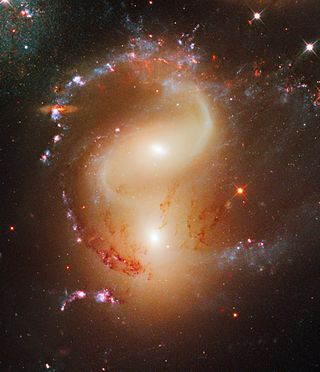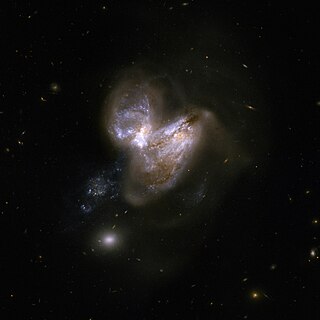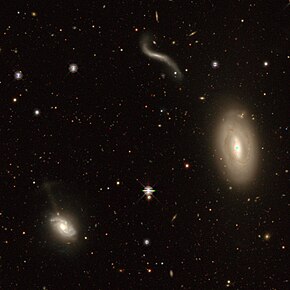
NGC 7318 is a pair of colliding galaxies about 280 million light-years from Earth. They appear in the Constellation Pegasus and are members of Stephan's Quintet. They were discovered on 27 September 1873 by French astronomer Édouard Stephan.

Arp 299 is a pair of colliding galaxies approximately 134 million light-years away in the constellation Ursa Major. Both of the galaxies involved in the collision are barred irregular galaxies. NGC 3690 was discovered on 18 March 1790 by German-British astronomer William Herschel.

NGC 5929 is a well-studied Seyfert galaxy in the constellation Boötes. It was discovered by English astronomer John Herschel on May 13, 1828. In the revised New General Catalogue it is described as "elongated, brighter toward the middle, with a slightly diffuse halo". This galaxy is located at an estimated distance of 133 million light-years. It forms an interacting pair with NGC 5930 at an angular separation of 0.5′; together they form entry number 90 in Halton Arp's 1966 Atlas of Peculiar Galaxies. A dust streak from NGC 5930 appears to lie in front of NGC 5929, suggesting that the former galaxy is the closer member of this pair.

NGC 3198, also known as Herschel 146 is a barred spiral galaxy in the constellation Ursa Major. It was discovered by William Herschel on 15 January 1788. NGC 3198 is located in the Leo Spur, which is part of the Virgo Supercluster, and is approximately 47 million light years away.

NGC 6120 is a peculiar spiral galaxy located roughly 440 million light-years away from the Sun. It is located in the northern constellation of Corona Borealis, and is a member of the Abell 2199 galaxy cluster.

NGC 146 is a small open cluster in the constellation Cassiopeia. It was discovered by John Herschel in 1829 using his father's 18.7 inch reflecting telescope.

NGC 243 is a lenticular galaxy located in the constellation Andromeda. It was discovered on October 18, 1881 by Édouard Stephan.

NGC 297 is an elliptical galaxy in the constellation Cetus. It was discovered on September 27, 1864, by Albert Marth and is classified as type E3, based on galaxy morphological classification.

NGC 298 is a spiral galaxy in the constellation Cetus. It was discovered on September 27, 1864, by Albert Marth. NGC 298 is situated close to the celestial equator and, as such, it is at least partly visible from both hemispheres in certain times of the year. Given its B magnitude of 14.7, NGC 298 is visible with the help of a telescope having an aperture of 20 inches or more.

NGC 315 is an elliptical galaxy in the constellation Pisces. Its velocity with respect to the cosmic microwave background is 4635 ± 22 km/s, which corresponds to a Hubble distance of 223.0 ± 15.7 Mly (68.36 ± 4.80 Mpc). In addition, eight non-redshift measurements give a distance of 208.58 ± 22.28 Mly (63.950 ± 6.830 Mpc). It was discovered by German-British astronomer William Herschel on September 11, 1784.

NGC 327 is a spiral galaxy in the constellation Cetus. It was discovered on September 27, 1864 by Albert Marth. It is described by Dreyer as "faint, small, extended." It is nearby galaxies NGC 329, NGC 325 and NGC 321.

NGC 380 is an elliptical galaxy located in the constellation Pisces. It was discovered on September 12, 1784 by William Herschel. It was described by Dreyer as "pretty faint, small, round, suddenly brighter middle." Along with galaxies NGC 375, NGC 379, NGC 382, NGC 383, NGC 384, NGC 385, NGC 386, NGC 387 and NGC 388, NGC 380 forms a galaxy cluster called Arp 331.

NGC 7002 is a large elliptical galaxy, and a radio galaxy, around 320 million light-years away from Earth in the constellation of Indus. The galaxy was discovered by English astronomer John Herschel on September 30, 1834. NGC 7002 is the brightest member of a group of galaxies known as [T2015] nest 200093. The group contains 12 member galaxies including NGC 7004, has a velocity dispersion of 440 km/s and an estimated mass of 1.28 × 1014M☉. NGC 7002 is also host to a supermassive black hole with an estimated mass of 2.7 × 109M☉.

NGC 7004 is a lenticular galaxy and a type 2 Seyfert galaxy around 330 million light-years away from Earth in the constellation Indus. NGC 7004 has an estimated diameter of 140,000 light-years. NGC 7004 was discovered by astronomer John Herschel on October 2, 1834. NGC 7004 is a member of a group of galaxies known as [T2015] nest 200093. The group contains 12 member galaxies including NGC 7002, has a velocity dispersion of 440 km/s and an estimated mass of 1.28 × 1014M☉. NGC 7004 is also host to a supermassive black hole with an estimated mass of 8.1 × 108M☉.

NGC 966 is an unbarred lenticular galaxy approximately 440 million light-years away from Earth in the constellation of Cetus. It was discovered by American astronomer Francis Preserved Leavenworth in 1886.

NGC 3923 is an elliptical galaxy located in the constellation Hydra. It is located at a distance of about 90 million light years from Earth, which, given its apparent dimensions, means that NGC 3923 is about 155,000 light years across. NGC 3923 is an example of a shell galaxy where the stars in its halo are arranged in layers. It has more than twenty shells. It was discovered by William Herschel on March 7, 1791.

NGC 3558 is an elliptical or a lenticular galaxy located 440 million light-years away in the constellation Ursa Major. It was discovered by the astronomer Heinrich d'Arrest on April 15, 1866. It is a member of the galaxy cluster Abell 1185 and is classified as a LINER galaxy.

NGC 1380 is a lenticular galaxy located in the constellation Fornax. It is located at a distance of circa 60 million light years from Earth, which, given its apparent dimensions, means that NGC 1380 is about 85,000 light years across. It was discovered by James Dunlop on September 2, 1826. It is a member of the Fornax Cluster.

NGC 1386 is a spiral galaxy located in the constellation Eridanus. It is located at a distance of circa 53 million light years from Earth, which, given its apparent dimensions, means that NGC 1386 is about 50,000 light years across. It is a Seyfert galaxy, the only one in Fornax Cluster.

NGC 1369 is a barred lenticular galaxy located 59 million light years away in constellation of Eridanus. The galaxy was discovered by astronomer Julius Schmidt on January 19, 1865, and is a member of the Fornax Cluster. NGC 1369 is a host to a supermassive black hole with an estimated mass of 1.8 million solar masses.



















